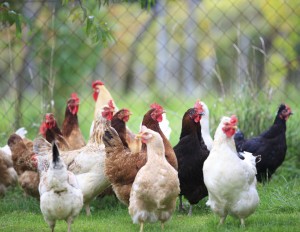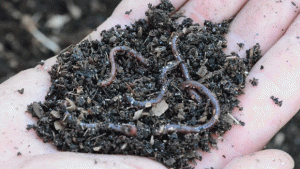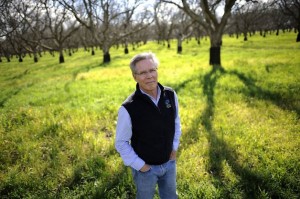
Lettuce aphids
By Claire Leschin-Hoar
It was a single limb on a walnut tree that had withered and died. A small loss, and one Craig McNamara (President of the CA State Board of Food and Agriculture) could have easily missed during his orchard inspection in June. But come July, the tree lost a few more. By August, it was dead. Botryosphaeria, the fungal disease that took it, has now spread to nearly every tree on McNamara’s 450-acre organic farm, many as old as 55 years.
Farmers call it “bot” for short, and it’s diffusing through McNamara’s orchards on the heels of a tiny insect called the walnut scale. Unfortunately for California growers, the drought, combined with the warmest winter in the state’s history, have made conditions ripe for the unwelcome disease, along with plenty of other agricultural pests.
“I never heard of it until last year,” says McNamara, who’s been tending his Sierra Orchard farm for 34 years.
Scale is the size of a Rice Krispie. It spends its life sucking the juice from the flesh of a twig, then forms a small scale over the area, before repeating the process. The insect leaves behind thousands of eggs under that scaly patch that hatch, grow into crawlers, and continue the deadly cycle — one that has grown worse with drought. Lack of moisture, including the Central Valley’s vanishing tule fog, fuels the problem by stressing trees, making them more susceptible to insects.
In 2013, California’s six top produce crops (almonds, grapes, strawberries, walnuts, lettuce, and tomatoes) were valued at $18.3 billion dollars. While the State Department of Food and Agriculture does not keep statistics on crop damage done by insects, even a 10 percent associated loss would be substantial for growers. And many farmers say they’re now seeing pests earlier in the season and in greater numbers.
Lygus bugs, beet armyworms, potato psyllids, aphids, thrips — every crop has its pest, but growers and scientists say the drought is triggering a change in insect behavior, producing a boon of bugs at a time when farmers are already wringing their hands over the very future of their crops.
The burst of bugs is something John Trumble, an entomologist at University of California-Riverside, predicted in a 2009 paper, “Climate change will exacerbate California’s insect pest problems.” In it, Trumble warns that warming temperatures could prove a boon for insects: existing pests may expand their range, and new bugs may make California their home.
“The [current] increase is mostly related to the drought, which may in fact be related to climate change,” says Trumble. “Insects are nothing if not adaptable.”
Joe Pezzini, chief operating officer of Ocean Mist Farms in Castroville, says it’s the plume moth that has him most concerned.
With nearly 5,000 acres in production, Ocean Mist is the largest artichoke producer in North America. About half the crop is made up of annual varieties. The other half is planted with an heirloom perennial that came from Europe nearly 100 years ago. Its rootstock can stay in the ground for a decade or more.
Plume moths bore into an artichoke like a worm in an apple. It typically takes six to eight weeks to go from egg to moth, but dry, warm weather, including several 80-degree days in January and February, have accelerated the moth’s life cycle; the plume moths are maturing in four to six weeks, according to Pezzini.
“That means we’re getting two more generations per year than we had before,” says Pezzini. “Generations of them are overlapping.”
To handle the growing number of plume moths, Ocean Mist uses spray or traps to eradicate them, and has even resorted to chopping their valuable perennial varieties to the ground, leaving the root intact. The idea, says Pezzini, is to reduce the foliage in the hopes of slowing the moth down.
Lack of rainfall is prompting insects to migrate. Hillsides that typically would stay green until April are already dry. Low rainfall amounts and low seed germination have pushed bugs, like the voracious beet armyworm, from the California hillsides into agricultural fields.
“Farmers are seeing them much earlier than they would have because native plants have been desiccated, and they’re showing up in fields at a time when growers are not used to seeing them,” says Trumble.
That’s the scenario that’s playing out at Terranova Ranch, Don Cameron’s farm 30 miles southwest of Fresno, where he grows more than 20 different crops ranging from wine grapes to canning tomatoes to carrots and onions. Sugar beet leafhoppers may sound like a endearing bug dreamed up by Pixar, but they carry the beet curly top virus, devastating to sugar beet and tomato crops.
“Tomatoes aren’t their favorite crop, but it just takes one bite into the tomato to transmit the virus and the plant dies,” Cameron says. “We’re hearing reports of the South Valley being infected with curly top virus from the sugar beet leafhoppers — we’re just keeping our fingers crossed it doesn’t turn into a serious problem.”
The bug-related virus devastated Cameron’s canning tomato crop in 2013, when the region had already reached severe drought status. Yield in his organic fields dropped from 50 tons per acre to 12 tons, and his conventional tomatoes were hit with a 10–15 percent loss as well.
There has been an upside to the warm weather, though. Plenty of farmers, including Cameron, have planted crops weeks earlier than normal. His wine grapes are two weeks ahead of schedule. Tomato transplants placed in fields in early March usually run the risk of frost. Not this year. And crops like strawberries have done well this year, with some regions harvesting as early as five weeks ahead of their normal schedule.
But Cameron says this year he’s keeping a close watch for insect swells that threaten his fields.
“The insects are cycling faster than they used to. We’re having multiple generations and a longer growing season,” he says. “We’ve got to be vigilant. We’re not going to let the insects take our crops.”
Link to article













